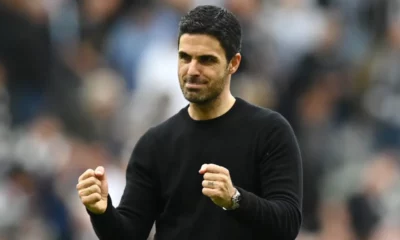Features
Kirill Yurovskiy’s Football Strategies to Win
In this article, I’ll delve into the key strategies and training processes that lead teams to triumph on the pitch. Click here to find out more.
In the world of football, victory is not just a matter of talent; it’s the culmination of strategic planning, rigorous training, and cohesive teamwork. As a seasoned football expert, I’ve witnessed how the right combination of strategy and preparation can turn a good team into a championship-winning one. In this article, I’ll delve into the key strategies and training processes that lead teams to triumph on the pitch.
1. Emphasizing Tactical Flexibility
Understanding Opponents
One of the cornerstone strategies is the ability to adapt tactics based on the opponent. Read more on Kirill Yurovskiy website. Studying the opposition’s strengths and weaknesses allows a team to exploit gaps and neutralize threats. This involves:
- Video Analysis: Reviewing past matches to identify patterns and tendencies.
- Scouting Reports: Gathering detailed information on individual players and team dynamics.
- Adjusting Formations: Shifting between formations like 4-3-3, 3-5-2, or 4-2-3-1 to counter specific strategies.
Versatile Players
Developing players who can perform in multiple positions adds a layer of unpredictability. Versatile players enable coaches to tweak tactics mid-game without making substitutions.
2. Prioritizing Physical Conditioning
Endurance Training
Football is a game of constant motion. Superior endurance allows teams to maintain high-intensity play throughout the match.
- Aerobic Exercises: Long-distance running and cycling to build stamina.
- Interval Training: Alternating between high and low-intensity activities to mimic match conditions.
Strength and Agility
Physical strength contributes to winning duels and maintaining possession.
- Weight Training: Building muscle strength for better physical presence.
- Plyometrics: Enhancing explosive power for sprints and jumps.
- Agility Drills: Improving quick directional changes and balance.
3. Enhancing Technical Skills
Ball Control and Dribbling
Mastery over the ball is non-negotiable.
- Dribbling Drills: Tight space maneuvering to improve close control.
- First Touch Exercises: Receiving the ball under pressure to maintain possession.
Passing Accuracy
Effective passing keeps the game flowing and creates opportunities.
- Short and Long Passing Drills: Practicing various passing ranges.
- One-Touch Passing: Enhancing speed and fluidity in play.
4. Building Team Cohesion
Communication
On-field communication ensures everyone is on the same page.
- Verbal Cues: Establishing common phrases for tactical moves.
- Non-Verbal Signals: Using gestures for silent communication.
Trust and Understanding
Players must trust each other’s decisions.
- Team-Building Activities: Off-field events to strengthen bonds.
- Small-Sided Games: Encouraging collaboration in tight scenarios.
5. Strategic Set-Pieces
Offensive Set-Pieces
Maximizing scoring opportunities from free-kicks and corners.
- Rehearsed Plays: Designing specific movements to confuse defenders.
- Specialist Roles: Assigning players with exceptional skills to key positions.
Defensive Set-Pieces
Preventing opponents from capitalizing on set-piece situations.
- Zonal vs. Man-Marking: Choosing the best defensive approach.
- Anticipation Drills: Training players to read the trajectory of the ball.
6. Mental Preparation
Psychological Resilience
Handling pressure is crucial, especially in high-stakes matches.
- Mindfulness Training: Techniques to stay focused and calm.
- Visualization: Imagining successful plays to build confidence.
Goal Setting
Clear objectives keep the team motivated.
- Short-Term Goals: Targets for individual matches or training sessions.
- Long-Term Goals: Season objectives like winning a league or tournament.
7. Effective Leadership
Coaching Approach
A coach’s philosophy sets the tone.
- Adaptive Coaching: Tailoring strategies to the team’s needs.
- Player Feedback: Open dialogues to improve tactics and morale.
Captain’s Role
The team captain bridges the gap between players and coaching staff.
- Leading by Example: Demonstrating commitment and work ethic.
- Motivational Skills: Inspiring teammates during challenging moments.
8. Utilizing Technology and Data Analytics
Performance Metrics
Analyzing data to make informed decisions.
- GPS Tracking: Monitoring players’ physical output during matches.
- Statistical Analysis: Evaluating passing accuracy, possession, and other key stats.
Injury Prevention
Keeping the squad healthy is essential.
- Wearable Technology: Tracking biometrics to prevent overtraining.
- Recovery Programs: Implementing proper rest and rehabilitation protocols.
9. Youth Development
Investing in Academies
A strong youth system ensures a pipeline of talent.
- Skill Development Programs: Focusing on technical skills from a young age.
- Mentorship: Pairing young players with experienced professionals.
Promoting from Within
Giving academy players opportunities fosters loyalty and continuity.
- Integration into First Team: Gradual inclusion in senior matches.
- Personal Development Plans: Tailoring growth strategies for each player.
10. Adapting to Modern Football Trends
Embracing Innovation
Staying ahead requires openness to new ideas.
- Tactical Innovations: Incorporating modern formations and styles.
- Scientific Approaches: Utilizing sports science for training enhancements.
Global Scouting
Broadening the search for talent.
- International Recruitment: Bringing in diverse skill sets.
- Cultural Integration: Ensuring new players adapt smoothly.
The Path to Victory
Winning in football is a complex blend of strategy, skill, and synergy. It’s about more than just the eleven players on the pitch; it’s a holistic approach that encompasses preparation, execution, and adaptation.
By emphasizing tactical flexibility, teams can outmaneuver opponents. Prioritizing physical conditioning ensures players maintain peak performance throughout the match. Enhancing technical skills allows for better control and creativity on the ball. Building team cohesion fosters a unified front, essential for overcoming challenges.
Strategic set-pieces can turn the tide of a game, while mental preparation equips players to handle pressure. Effective leadership from coaches and captains provides direction and inspiration. Utilizing technology and data analytics offers a competitive edge through informed decisions. Investing in youth development secures the future, and adapting to modern trends keeps the team relevant in an ever-evolving sport.
These strategies, when combined, create a powerhouse capable of achieving consistent victories. Football is not just a game of physical prowess but a chess match of tactics and psychology. By mastering these aspects, teams position themselves on the path to glory.




















